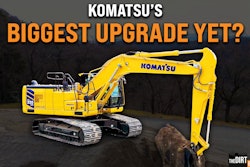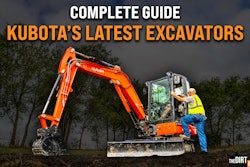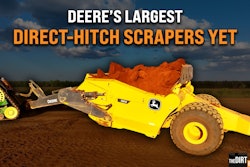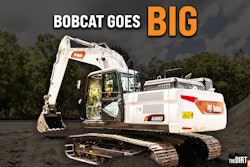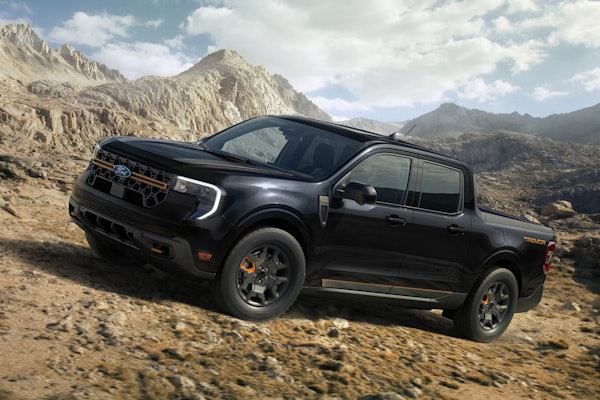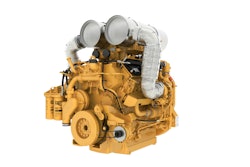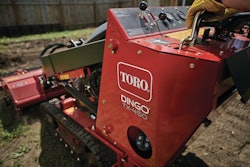Caterpillar launched the redesign of its top-selling motor grader this year, and on this episode of The Dirt, we take a look at all the many features and options available on the new 140.
Eric Kohout, Caterpillar product specialist, gives a detailed look at the new grader and how it can be configured in a variety of ways to satisfy old-school operators as well as the less experienced.
The 140 can be ordered with steering wheel and levers or with joysticks. That customization includes going from a simple grade gauge up to 3D mastless machine control.
Kohout lays out the advantages and disadvantages of the steering wheel versus the joystick system, as well as the many levels of grade control offered. He also discusses the easier maintenance of the 140, as well as the new, optional high-performance circle designed for “no adjustments for the life of the grader.”
Depending on the configuration, the graders deliver 179 to 250 horsepower and have operating weights of 38,725 to 44,613 pounds. They can be equipped with 12- or 14-foot blades and with all-wheel drive.
The main applications for motor graders are finish grading, road maintenance and snow removal. However, Kohout details some other uses operators often don’t consider that can make a big difference on jobsites.
So to learn more about the best-selling motor grader in the U.S., check out the latest episode of The Dirt.
Tap into the power of Fusable's vast industry intelligence – over 100 million entities, activities, and transactions – to identify and capitalize on new growth opportunities for your business. Explore at Fusable.com/TheDirt. (Fusable is the parent company of Equipment World and the sponsor of The Dirt.)
In This Episode
- 00:00 – Cat’s Next-Gen 140 Grader
- 00:46 – Control Offerings: Joystick or Piano Keys
- 02:43 – Floor-Mounted Joysticks
- 03:48 – Control Feedback
- 06:04 – Joystick Controls Extending Careers
- 08:45 – Motor Grader Versatility
- 10:05 – Underutilization of Motor Graders
- 12:12 – Machine Control: Bubble Gauge
- 13:32 – Machine Control: IMU Sensor
- 13:49 – Machine Control: Cat Grade ARO
- 14:28 – Machine Control: Cross Slope Assist
- 16:04 – Machine Control: Mastless 3D System
- 17:36 – Mastless 3D Advantages
- 17:58 – Slope Assist Advantages
- 19:08 – Sensor Protection
- 20:59 – Serviceability: Drawbar & Circle
- 22:13 – Serviceability: Fuel Tanks
- 22:49 – Serviceability: Pump Location
- 23:09 – Serviceability: Articulation Cylinder
- 23:36 – Serviceability: Engine Compartment
- 25:56 – Serviceability: Rear Frame
- 26:43 – Final Thoughts
Equipment World serves up weekly videos on the latest in construction equipment, work trucks and pickup trucks — everything contractors need to get their work done. Subscribe and visit us at equipmentworld.com!
00:00:00:02 - 00:00:27:18
Bryan Furnace
Equipment dealers know your market inside and out with feasible dealership solutions. Do more with good [email protected]. Slash the dirt. Hi everybody. Welcome back to Equipment World. You're watching the dirt. I'm your host Bryan. And today we're here to talk about the new cap 140. It is a different machine. They have redone a bunch of things and improved. And today we're going to hear about it from Eric with caterpillar.
00:00:27:20 - 00:00:32:00
Bryan Furnace
Well Eric, thank you so much for taking time to be on the dirt today. I really appreciate it.
00:00:32:02 - 00:00:34:13
Eric Kohout
Hey, thanks for the invite and glad to be here.
00:00:34:15 - 00:00:54:01
Bryan Furnace
Yeah, any time, especially when we're here to talk about blades. That's kind of that's one of my favorite pieces of equipment on the jobsite. It's kind of the pinnacle of of most guys careers. When they finally get in the seat of one of these machines and so on. The note of that being the career piece that a lot of guys, kind of work to get into.
00:00:54:03 - 00:01:13:02
Bryan Furnace
One of the topics of hot debate when it comes to graders specifically and especially with your machines, is the controls. I know when you guys went to the joystick controls a while back, a lot of the old guys in the industry had an issue with that. Are you guys offering the piano keys these days or is it still joystick only?
00:01:13:04 - 00:01:34:20
Eric Kohout
Great question. Absolutely. We are offering both. So we have that steering wheel and mechanical levers, also known as piano keys or the joysticks, you know, and when it comes down to it, it's kind of like lots of other products in the industry, whether it's ISO or saggy when it comes to excavators or to lever versus joystick on loaders, things like that.
00:01:34:22 - 00:02:00:13
Eric Kohout
Same thing here. So we do offer that steering wheel and mechanical levers, also known as piano keys. You know, because those folks, what they're looking for is just that familiarity of those controls. You know, they've had it since the H series or some previous series, and they want to continue. They feel very efficient with it. But one of the other reasons people really like those levers is they like the feel, you know, because it's as old school as you can get.
00:02:00:13 - 00:02:21:10
Eric Kohout
It's a lever to a rod right down to the valve. So as you are cutting and doing work, you feel forces through those levers because of, you know, more pressure in the hydraulic system, you know, so that you know what's going on, you see with your eyes, but you also are able to feel that with those lever controls.
00:02:21:12 - 00:02:43:02
Eric Kohout
Now, obviously, we'll continue with the joysticks too. You know, with joysticks, the people really like to sit back. You know, they like that 78% reduction and hand and wrist movements that allow you just to go left and right with the joystick for steering versus multiple turns with that steering wheel. They like that ability to have that different visibility out the cab because we have that angled cab.
00:02:43:04 - 00:03:08:08
Eric Kohout
So the thing to to remember is a lot of folks ask when it comes to controls on the joysticks, hey, why are you for mounting your joystick controls? And the reason we floor mount our joystick to the cab is because we're trying to get some of that feel that those lever folks are used to because vibrations, feelings, things like that move up through the whole board and through the circle and the drawbar up through the machine into the cab.
00:03:08:08 - 00:03:30:12
Eric Kohout
And you're able to kind of feel some of that feedback via floor mounted control. So whether you choose steering wheel levers, because, hey, that's what you're comfortable with or joystick, you know, we try to provide that feeling for it, you know? And the funny thing is, is talking with people. It's not one size fits all. I mean, obviously there's those that are one control or the other.
00:03:30:12 - 00:03:48:03
Eric Kohout
There are mixed fleets out there. You know, some people are doing heavy bulk work and technology with, you know, the joystick graters. And they may be doing some finished work with that steering wheel lever machine just because of the feel differences or the preferences for the type of application that they're doing.
00:03:48:05 - 00:04:10:12
Bryan Furnace
It is interesting. The graters just one piece of equipment that within the last five or so ten years that you guys introduced joystick controls, there's kind of been this, this hot topic of debate about the mechanism by which you're operating with, but on other pieces of equipment here in the last 5 to 7 years, we've seen a lot of those go from regular mechanical controls to controls.
00:04:10:12 - 00:04:30:15
Bryan Furnace
And the same debate always happens. It's, oh, I can't feel anything in my hands. Oh, I've lost so much of my ability and and really my experience, I used to I used to run a loader on a pipe crew and, and I had an old machine that had the, the regular mechanical controls. And then I got put into a machine with the new age and, and your initial gut is absolutely you.
00:04:30:17 - 00:04:52:11
Bryan Furnace
You've lost all of your feel, all of your finesse. But really, what happens if you kind of just take a step back and and breathe for a second is you start to develop those skills and you start to get that feedback just from different areas. Because I did notice that I started to get my finesse back and that machine, but I wasn't getting feedback from the joystick anymore.
00:04:52:11 - 00:05:08:18
Bryan Furnace
I was starting to get it more from my chair, from feedback in the steering wheel. There's other ways you can get that feedback. And so I do feel like for a lot of these old school guys especially, they get so hung up in, I've lost everything. You can't this thing's a piece of garbage. You just can't operate that.
00:05:08:18 - 00:05:29:17
Bryan Furnace
They don't ever really give it a shot to actually retrain themselves. And realistically, you're talking a couple of days, maybe a week, that you get that feel back and you start to get that feedback from other areas and you're just as good as you were before. But I think it's just that mental hurdle of getting over that change, which, as we all know in our industry, no one likes change.
00:05:29:19 - 00:05:48:10
Eric Kohout
No, exactly. You know, and that you bring up a great point. That's the thing. I mean, where you're putting the mood board, where you're putting the circle, where you're articulating those things haven't changed regardless of the control system. You know, it's just how are we getting the machine to that set up so that you can do that task?
00:05:48:12 - 00:05:56:22
Eric Kohout
Is the biggest thing that really has changed. I mean, we're not changing how we move dirt. We're just changing how to manipulate the machine to do what you need it to do.
00:05:57:00 - 00:06:23:12
Bryan Furnace
Absolutely. It's you're not having to relearn how to operate from ground zero. You just having to get feedback from different areas. Yeah. And also to another point that you made, there are a lot of guys that just swear by the old piano keys. But at the same time I've, I've random both ways, very limited. And I can imagine that doing this all day long, using individual fingers versus having joysticks with very simple light touch clicks.
00:06:23:12 - 00:06:37:08
Bryan Furnace
I mean, talk about an anti-fatigue mechanism. You know, I can imagine this would just get so exhausting over the course of a day versus those joysticks where everything's just at a fingertips reach. That's that's got to be so much easier on the hands.
00:06:37:10 - 00:06:58:18
Eric Kohout
No, I mean absolutely. Let's look at a base grader. You're looking at a steering wheel and eight lovers and a transmission control. So you really have four different locations. Left side of the levers, steering wheel right side of the levers and the transmission control. You're moving your hands left and right all day long, depending upon the type of application you're doing.
00:06:58:22 - 00:07:21:00
Eric Kohout
We've incorporated all that onto these two joysticks, three access joysticks that allow the folks to be able to keep their fingers and hands on the controls. And you're absolutely right. I mean, a lot of people look at these joysticks and go, well, I wasn't raised with the gaming systems and things like that, but, I mean, some of our biggest advocates haven't been just the young generation.
00:07:21:00 - 00:07:51:15
Eric Kohout
It's actually been some of the older operators. We've heard stories from some of the older operators that have extended their careers. I talked to operators that it went back to having going bowling and doing things after hours. Because, you know what? Do you just feel less fatigued? I mean, you are holding your shoulders kind of in a more tight position and upper back with the levers and it's a really great setup, but sitting back and just being able to relax has helped a lot of folks extend their careers greatly in some terms, five, ten years more than they thought.
00:07:51:15 - 00:07:59:09
Eric Kohout
Maybe they would be able to handle it. So it is definitely something that makes life a lot easier for some operators.
00:07:59:11 - 00:08:24:00
Bryan Furnace
That makes total sense. And I guess I've never really thought about the the additional body fatigue, but but it makes total sense if you think about it. Most of those piano key guys are very forward. They're looking down, your shoulders are engaged, upper body is engaged, versus with those joysticks. I mean, you're really getting comfortable in if you're going to pay a lot of money for a very comfortable seat in a machine, use it, sit back in it, adjust the seat.
00:08:24:00 - 00:08:48:13
Bryan Furnace
That's what I always tell new operators is actually take the time to adjust that seat. Those suckers are expensive. Yeah, this is going to be your office chair all day. Make it yours. But to be able to sit back with those joysticks now total upper body relaxation. Your shoulders are in a very relaxed position. You got rest supporting I mean there's just overall it's so much more ergonomic.
00:08:48:15 - 00:09:08:15
Eric Kohout
You talk to people about what a grader does and typically they come up with three main applications. It's finished. Great work. So it's coming in and doing the work just before the paver comes in. Or, you know, after the motor grader goes, the compactor comes in and then they put down paving. The other one is you see a lot of them, especially in North America, there's rural roads that need to be maintained.
00:09:08:15 - 00:09:27:07
Eric Kohout
There's a lot of road maintenance. And then of course, as you move further north, there's snow removal. Those seems to be the three applications most people look at a grader. But, you know, graders do a really good job on slope work. They do really good at ditch work and cutting and laying out material articulation. You know, if you need articulate.
00:09:27:07 - 00:09:52:18
Eric Kohout
Obviously, the big one is a lot of people use it for turning. But have you thought about utilizing that too? You know, you got too much load on your whole board. You can basically offload some of that load on that mold board by articulating doing a flat bottom ditch. You know, you're fully articulated. You're taking that 14ft mold board and suddenly you're making a three-foot cut because you're able to utilize and manipulate that mold board differently when you add articulation and things like that.
00:09:52:18 - 00:10:04:22
Eric Kohout
So it's really just getting people and getting them comfortable and seeing what a motor grader can do and be thinking beyond just finished work, road maintenance, snow removal for applications.
00:10:04:22 - 00:10:25:06
Bryan Furnace
So this is a little bit of a tangent, a little bit of a sidebar, but I do feel like the grader is one of those machines to where kind of getting in there and figuring it out doesn't really cut it. And and I think we're seeing that on a lot of job sites. You have I would say probably the majority of operators that are in those machines are very skilled.
00:10:25:06 - 00:10:42:23
Bryan Furnace
They're very good at what they do, but they also have a very limited knowledge base because they were kind of thrown the ropes and said, hey, figure it out. And then you watch videos of some guys that really know how to run a grader. And like you're talking about, I mean, watching a skilled operator do slope work or ditch work with one of these machines is unbelievably impressive.
00:10:43:00 - 00:11:08:21
Bryan Furnace
I bet 80 to 90% of companies out there would never even think to utilize a grader for those applications. And to be honest, their operator probably couldn't use the grader in that application just because they simply don't know how you. So I do think the grader in particular is one of the machines that we just don't do nearly enough to train our operators, even the old school guys that have all of this knowledge are really lacking to really fully utilize the machine.
00:11:08:23 - 00:11:27:13
Eric Kohout
Absolutely. I mean, and that's the thing I mean, knowledge transfer, that was one of the challenges sometimes with the grader is the folks that were good operators, some want to share that information and be able to bring somebody else up to speed. A lot of them like to hold on to it because you know what, to be honest, they work their tails off to get where they're at.
00:11:27:13 - 00:11:50:21
Eric Kohout
So they kind of, you know, in a way want to hold on to that. But there are some things that are out there. Now. What we have is we have an application guide. We also have videos out there for certain little things to be able to just help improve and operators’ confidence. So there are definitely a lot of great things that we offer as well as passionate blade hands have out there for people to learn.
00:11:51:01 - 00:11:51:10
Eric Kohout
Yeah.
00:11:51:13 - 00:12:18:18
Bryan Furnace
And I would encourage everyone in the industry I never stop learning. And that's that's one of my big mottos in the industry is don't ever think you've reached the mountaintop of your skill level because you don't you don't ever get there. There's always something new to learn. There's always some new skill that you can pick up from someone else by observing and watching, kind of getting back to the new 140 though, machine control, what do you guys offer and what is standard on this machine?
00:12:18:18 - 00:12:39:21
Bryan Furnace
Am I able to get a barebones grader, or am I forced to kind of have some of that technology integrated on it? But before we get into that, I want to take a second to tell you about the sponsor of this video. Equipment dealers want an edge in today's market. Fusable provides the crucial sales data and market analysis you need to make smarter inventory and sales decisions.
00:12:39:23 - 00:13:10:06
Bryan Furnace
Imagine knowing exactly what's selling in your region, understanding emerging trends, and optimizing your stock to meet demand. With Fusable flagship products like EDA data, you're not just reacting to the market, you're anticipating it. Get the advantage at fusable.com/the dirt. What do you guys offer and what is standard on this machine? Am I able to get a barebones grader, or am I forced to kind of have some of that technology integrated on it?
00:13:10:08 - 00:13:31:21
Eric Kohout
What we do offer standard for everybody on a lever machine is the bubble gauge in the cab window. So, I mean, at a bare minimum, you have some grade system. It's just a simple little level meter with a degrees and percentage. So that is definitely part of the barebones offering with no technology is still has that bubble level.
00:13:31:23 - 00:13:48:18
Eric Kohout
You know, the next one up is just a simple IMU sensor or inertial measurement sensor that is a digital blade slope meter, giving you basically a digital readout of that bubble gauge. It's in the cab. So somebody wants to be able to just look at the display to kind of quickly glance and see what they have going on.
00:13:48:20 - 00:14:09:07
Eric Kohout
And then once you get into that, you've got different levels. You know, if you're in a scenario where you know what I want a grader, I'm not sure about technology right now, but maybe later I'll add a 2D or 3D system. We do have a thing called cat grade arrow attachment ready option gives you the plug and play capability, gives you the wiring harness is the sensor mounts.
00:14:09:11 - 00:14:27:18
Eric Kohout
It also provides you the blade mass brackets and a position sensing cylinder board cylinder that just gives you great architecture to be able to add that in the future, you know, so some people are wanting a grader and they've got a job that maybe doesn't require it. And then in the future they do want, and we have that capability.
00:14:27:18 - 00:14:47:20
Eric Kohout
And then we also on the lever machine now have what's called cross slope assist. Cross slope assist gives the ability for and that's a 2D system giving the operators the ability to either have it as an indicate, because it's got six sensors on it, it's got pitch of the machine, it's got rotation on the board, it's got blade flow.
00:14:48:01 - 00:15:06:14
Eric Kohout
It's also got a drawbar sensor, a yoke sensor. That yoke sensor is when you shift that drawbar circle and roll board, those two lift cylinders still turn. So you know, when you center shift, a lot of people think it just goes straight to the left and right, but it actually has a slight curve or arching pattern. And we need to capture that rotation.
00:15:06:16 - 00:15:28:06
Eric Kohout
And then we have that position sensing cylinder. So the point of that is allows you to be able to have an accurate system even when you center shift, but it's in an indicator so the operator can use it and it's constantly reading out actual blade slope. Or you know what if they would like to and they know, say you're they're working on an oil field pad and it's a 0% slope.
00:15:28:06 - 00:15:50:08
Eric Kohout
And they want to be able to dial that machine and they can put 0% slope in. And then they choose which side is manual and which side is automatic. Typically. Not always. People like to have the automatic side B their discharge side or the heel of a mole board, and then they manually control the toe. And then what happens is they choose auto on the discharge or the heel side.
00:15:50:10 - 00:16:17:20
Eric Kohout
They control the elevation of the manual side. And the machine controls the 0% slope in this case, or 2% slope or whatever the case may be, as well as you can use that system with other sonics and other things as well. And then we now have as well on this lever machine and industry exclusive mastless 3D system. So, you know, you see a lot of graders out there with those two mass on that board, and they've been out there for decades.
00:16:17:20 - 00:16:42:09
Eric Kohout
And that's just kind of the way it's been. We had it on the joystick since 2020, but now on levers, we are taking those mass off. We're putting that infrastructure on the machine, those six sensors plus the receiver for the antennas, the GNSS or GPS receivers are on the machine. Now. Suddenly these operators are going out. They're using these motor graders with more applications because they're not worried about that mass.
00:16:42:09 - 00:17:03:15
Eric Kohout
That mass is not going to catch a tree. It's not going to go into the cab and knock the cab glass out or bend the mass. It's integrated onto the machine. The other thing with the Marcellus system, whether it's a joystick or lover, set up time, you know, the machine's ready. It's ready to go. You turn it on, it checks the system, and you go to work.
00:17:03:20 - 00:17:23:18
Eric Kohout
Otherwise, when you have those mass, you typically have those high price receiver antennas on each mast. You're having to take them off at the end of the day, put them on. You're probably grading for another hour, maybe an hour and a half every day because there's no set up or take time. So that's kind of the value. So Bryan, you got no technology if you really just need a grader.
00:17:23:18 - 00:17:36:06
Eric Kohout
That's simple and straightforward and that's what you're comfortable with all the way up to a full mastless system. The operator focuses on the work, the task at hand and not worry about what's going on with mass, because they are not on that machine.
00:17:36:08 - 00:17:56:11
Bryan Furnace
Yeah. Not having the mass is huge. That's one of those things where I guess until you're really in the machine, you don't realize how limiting those things are. As the as far as the ability to kind of pivot the turntable, bring that blade in a little closer to you. There's a lot of ways in which those mass really limit your range of motion that you wouldn't really think about until you're in one.
00:17:56:17 - 00:18:12:18
Bryan Furnace
So that's awesome. I did also want to say the the 2D slope assist. You want to talk about taking fatigue off of the operator. For a lot of these county guys that are going around great and roads all day long, to be able to set that at a 2%, 3% slope. And all I got to do is worry about the crown of my road.
00:18:12:18 - 00:18:29:16
Bryan Furnace
I don't have to worry about the discharge side. Like you said, all I got to do is make sure that my motherboard's loaded with material and I'm off to the races. And now every road's got a 2 to 3% slope on it when I have to worry about drainage issues, and it took far less effort and mental concentration than it used to, you know.
00:18:29:16 - 00:18:50:22
Eric Kohout
And the other thing to realize when that happens is when you're at a true slope, when you go to put re material, these roads, when they're consistent and you know, on slope, you're only putting a thin layer consistently across that entire surface. You're not having to fill in low areas or there's other areas that don't need as much.
00:18:50:22 - 00:18:59:12
Eric Kohout
So ultimately you can actually take that material and make it go longer than you previously did. If you have that consistency of that road.
00:18:59:14 - 00:19:18:16
Bryan Furnace
Absolutely. There's a lot more benefits than even what you just recognize. At the surface, it's it's a significant improvement to the old school way of doing it. So now I do have a question for you about all those sensor. So let's say we go with a fully decked out machine. How protected are those sensors? Are you guys seen a lot of guys knocking those things off, damaging them?
00:19:18:16 - 00:19:28:07
Bryan Furnace
We all know that guys like to set that bar down and do a little backtrack from time to time. Is that something where you're having issues, or are those sensors pretty well protected?
00:19:28:09 - 00:20:05:03
Eric Kohout
They're pretty well protected. I mean, obviously if someone would try hard enough, I'm sure, or not be thinking about it, something could happen. But all those sensors are protected, especially if they're close to the dirt or protected in a box. The wiring harnesses are come out. Those boxes they're using, it looks like a hydraulic line and fitting, you know, that's kind of hard mounted to that box so that we have rigidity in that wiring harness as and basically that wiring harness runs through that looks like a hydraulic hose to just give some more structure and protection to those wiring, like it's really the wiring harnesses.
00:20:05:03 - 00:20:24:18
Eric Kohout
It's not so much the sensors. The fence is a pretty or the I am user. Inertial measurement units are pretty robust. It's really, you know, pulling and tugging on wires is probably the biggest challenge. So you can get those pretty well protected. Then you have a better chance of not having issues. And so we haven't had a whole lot of those issues.
00:20:24:18 - 00:20:47:14
Eric Kohout
We do have customers and dealers come in and look at these machines and go, hey, you're going to have a hose rub here. You're going to have, you know, a wire thing here. So they've already kind of helped us vet some of these possible areas where we could, including the sensors. So we're trying very hard to protect those, make life easy for the operator so that they have peace of mind even after aggressive application.
00:20:47:20 - 00:21:07:05
Bryan Furnace
That's good to hear. At the end of the day, you can't fix stupid and you can't fix someone who's going to abuse the equipment, but at least they're protected from everyday normal usage of the machine. So my final question is, serviceability. What kind of improvements have you guys made to the 144? Just making it easier to work on?
00:21:07:06 - 00:21:32:16
Eric Kohout
You know, we've got depends on where you want to start here. We can start kind of in the front. I mean from a serviceability standpoint we still have our top a just drop our circle mole board, you know, that allows you to ship them up and keep that connection tight between the drawbar and circle. We also have the optional high-performance circle that takes all the shims issues, all the circle teeth, all that stuff that you may have experienced and needed to maintain in the past.
00:21:32:18 - 00:22:02:21
Eric Kohout
And it's an excavator bearing. So between that circle and drawbar, basically all it is is three grease fittings with a nested grease bank. All you do is as you grease your bowl, studs and other locations on the machine is grease those quick locations and it takes care of everything. So that does reduce quite a bit of maintenance on the drawbar circle connection, which is obviously pretty critical for folks because, you know, when you lift, you want that cutting edge to follow the lift command or the lower command.
00:22:02:21 - 00:22:18:14
Eric Kohout
You don't want a whole lot of movement. So if we can take movement out of that and make life easier for folks and not have to rim and do other things, that high performance circle will do that. You know, some other things we've done is those fuel tanks we have on our machines have been plastic and they've been great.
00:22:18:14 - 00:22:45:13
Eric Kohout
We've had not a lot of issues with them. But you know, what they did block is any potential issues that a technician may need to service underneath that cab. So what we've done with the 140 here is we've actually taken that front frame, that cavity that's right underneath the cab. We've turned that into the fuel tank with that is now suddenly all the hose routings and all the valve access and other things that you were struggling with before, it's more accessible on this machine.
00:22:45:13 - 00:23:07:11
Eric Kohout
So it looks a lot more clean and open as well. As we move the pumps in the back engine compartment, you know, under the cab, they are kind of hard to get to. Now, when you get into the back of that engine compartment, you have accessibility of those pumps on the right left-hand side. So moving that makes it quieter for the operators but also makes serviceability better for the technicians.
00:23:07:13 - 00:23:27:01
Eric Kohout
As well. You know, something else we've done is a lot of these things a little things. So we're going for a contactless articulation cylinder. And what that allows is there's no rods; there's no major adjustments that are needed like previous. So that's just less things for an operator and and a customer to worry about. We move those articulation cylinders out more.
00:23:27:01 - 00:23:53:18
Eric Kohout
You know, easier accessibility. You know, if there would happen to be, unfortunately, a leak or something else that you need to service so you have greater accessibility to those as well as let's get into the engine compartment. We've basically redone that entire engine enclosure structure, easier to use handles to open and close the doors. Our previous ones were twist, and if they weren't adjusted, they would, you know, not function quite as well as people would like and they get frustrated.
00:23:53:20 - 00:24:14:18
Eric Kohout
The other thing is, when you opened one of those doors on the previous series machines, you were just opening basically that square. That was the door. But what we've done is we've taken a little part of that top of that engine enclosure and added it to the door. So now when you open that door, not only are you opening the door to gain access, but you also have better topside access.
00:24:14:18 - 00:24:49:23
Eric Kohout
If you need to get to the top side of that engine or other components in that area. And then once you open those doors, we have no tools, lower panels that you pull out. So you have four doors and four panels, and you pretty much have framed the top of engine compartment access to any serviceability items that you need to get into that engine compartment, just making it a lot easier for technicians, whether they just happen to need a little bit more accessibility or they need to get batteries out or do things like that, we've done quite a bit as well as the other thing we've done is we've moved filters up our transmission filter
00:24:49:23 - 00:25:10:11
Eric Kohout
was down kind of in the dirt. We've moved that up to in kind of in your face and accessible just because if we make things easier for technicians and for operators or whoever's doing the maintenance, the more likely it is that something's going to get done. We also have no tools to open the rear door. Any cooling access or access to all sides of the cooler.
00:25:10:13 - 00:25:27:14
Eric Kohout
You have that rear door, you have accessibility between them. You have accessibility in the front. So if you do get into applications where there's a lot of debris, you have a standard reversing fan, but then you also have the ability to get into all these coolers from all sides, to be able to clean out debris and do things like that.
00:25:27:18 - 00:25:46:23
Eric Kohout
You know, if you look at our current machine, we had an after-treatment fan on top of it. We had the cleaner on top from an operator perspective, when they looked out the rear window, there was a lot of clutter on top of that engine compartment. You know, it's been great and they've worked around it, but now all we have on that back of that engine compartment is just that stack.
00:25:46:23 - 00:26:12:12
Eric Kohout
Everything else has been moved to some other location to make it cleaner and easier for operators to be able to see what's going on over the back of the machine. Other things we've also done is we've put a new rear frame on that machine, and now we're actually just bolting the ripper to it, so you don't have to worry about the tag lengths or adjustments and making sure things are tight and lined up properly.
00:26:12:12 - 00:26:42:12
Eric Kohout
And some people do take rippers on and off. It's a lot easier just bolt on a new ripper. So we're really trying to take care of the folks who are obviously making the decisions and paying the bills and lowing their costs. We're also looking at the operators. How can we make life easier for them? And definitely those technicians, because if they can get in, they got access to it, they can get service work done, then suddenly they're up and going faster, just making life easier for all three parties that are involved in maintaining, purchasing and operating these machines.
00:26:42:14 - 00:26:48:09
Bryan Furnace
Well, Eric, I appreciate your time and all the information on the new 140. I'm excited to see that roll in some new job sites.
00:26:48:14 - 00:27:09:11
Eric Kohout
No, absolutely. I highly encourage you all. Do you want to talk nuts and bolts? You want to talk about history. You want to talk about the machines that will have a context. I'll come look me up. I'm gladly spend some time and geek out over graters. You know, all my coworkers laugh all the time because they do see me starting to geek out, and they sometimes have to bring me back down.
00:27:09:11 - 00:27:15:06
Eric Kohout
So I look forward to seeing people at Expo, and I appreciate your time here today, Bryan.
00:27:15:09 - 00:27:34:09
Bryan Furnace
Well, thank you again for Eric joining us to talk about the new 140 and all of the improvements made. I can honestly say one of the most exciting things for me is the Marcellus Mole board. That is going to be a huge improvement in visibility to workability of the machine. Just an overall really great improvement. As always, I hope this helps you and your business.
00:27:34:12 - 00:27:36:03
Bryan Furnace
We'll catch you on the next episode of The Dirt.
